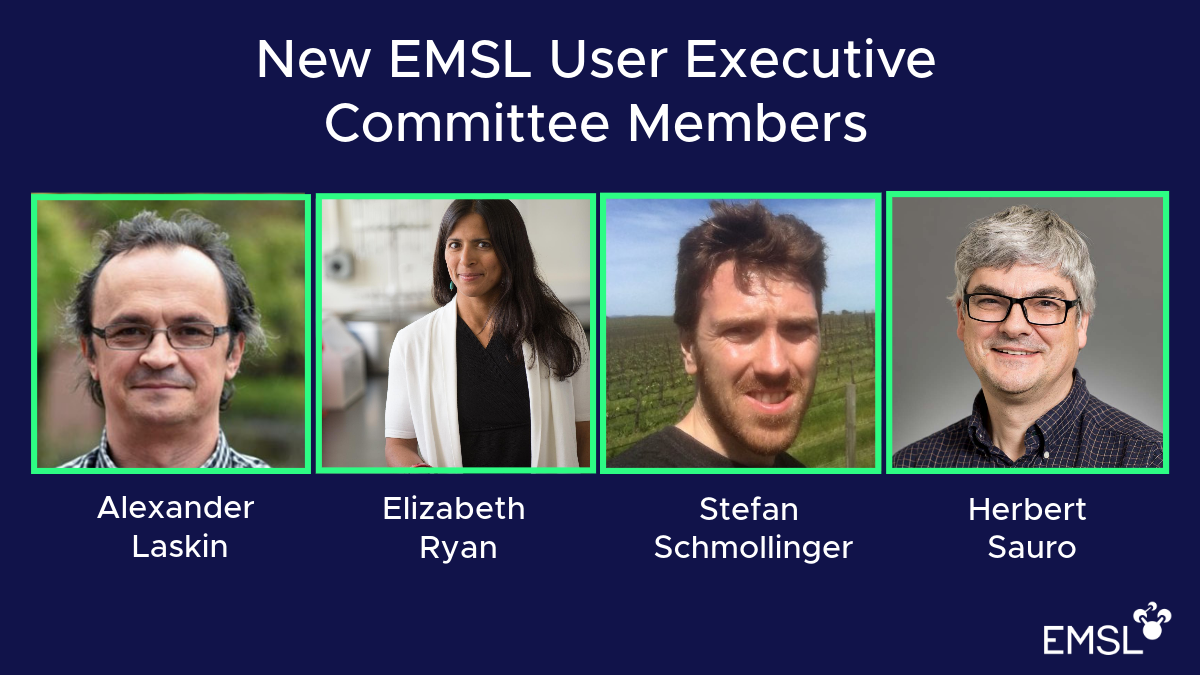Four Researchers Elected to EMSL User Executive Committee
New members represent each of EMSL’s science areas

Four new members have been elected to the EMSL User Executive Committee, which provides advice and recommendations to EMSL leadership on matters affecting users. (Image provided by Adobe)
The Environmental Molecular Sciences Laboratory (EMSL) User Organization has elected four researchers as the newest members of the EMSL User Executive Committee (UEC).
The new members of the UEC are Alexander Laskin, Elizabeth Ryan, Stefan Schmollinger, and Herbert Sauro. Each will serve a three-year term on the UEC. The UEC provides advice and recommendations to EMSL leadership on matters affecting EMSL users.

Alexander Laskin
Alexander Laskin is a professor of analytical chemistry at Purdue University where his research focuses on the fundamental understanding of multi-phase chemistry of atmospheric aerosols and interfaces. In addition to being an EMSL user, Laskin worked at EMSL and Pacific Northwest National Laboratory from 1999 to 2017.
“As a researcher with both ‘inside’ and ‘outside’ experience now, I do believe that I could be in a good position to be a strong advocate of EMSL for the scientific community, especially in the Atmospheric System Research- Department of Energy domain and contribute to the success of EMSL beyond my own research interests,” Laskin wrote in his nomination letter to the UEC. “Overall, EMSL has been a home for me for 18 years, and I do feel personally obligated to contribute to its future success as well.”
Elizabeth Ryan
Elizabeth Ryan is a professor at Colorado State University (CSU) in the Radiation Cancer Biology and Oncology section of Environmental and Radiological Health Sciences. She leads the Elizabeth Ryan Toxicology, Cancer Biology, and Nutrition Laboratory. Ryan’s research includes studying the complex interactions of food components with gut microbiota and the immune system. She has joint appointments with the Department of Food Science and Human Nutrition at CSU, the Colorado School of Public Health, and the University of Colorado Cancer Center.
As an EMSL user, Ryan's laboratory collaborated with EMSL on metabolomics and metaproteomics for COVID-19 response work. This project involved multiomics profiling of SARS-CoV-2 infections in adults.
Stefan Schmollinger
Stefan Schmollinger is a research assistant professor in the Department of Biochemistry & Molecular Biology at Michigan State University where he studies alga nutrient management. He is a member of the Strenkert lab, which uses systems biology to obtain a quantitative understanding of gene regulation in photosynthetic organisms.
Schmollinger is a co-investigator on an EMSL Exploratory Research project looking at stoichiometry changes to photosynthetic structures in algae in response to environmental stimuli and genetic engineering.
Herbert Sauro
Herbert Sauro is a professor in the Department of Bioengineering at the University of Washington. His research includes predictive models of disease, best practices for computational modeling, control theory applied to cellular networks, and development of approaches for mechanistic modeling of cells. Sauro is also the director of the National Institute of Health’s Center for Model Reproducibility, which is designed to develop comprehensive predictive models of biological systems.
In October, Sauro was awarded funding through the EMSL Large-Scale Research proposal call for his project, Inferring Kinetic Models for Large-Scale Biochemical Networks. Through his project, Sauro is developing an iterative model ensemble approach for model building that incorporates existing knowledge and is designed explicitly for hypothesis generation. Adversarial machine learning is being used to evaluate the ability of this method to recapitulate the benchmark models.
For more information on the UEC, see the UEC charter on the EMSL website.

